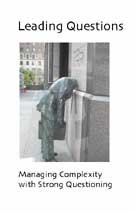fno.org
|
|
| Vol 17|No 4|March 2008 | |
| Please feel free to e-mail this article to a friend, a principal, a parent, a colleague, a teacher librarian, a college professor, a poet, a magician, a vendor, an artist, a juggler, a student, a news reporter or to anyone else you think might enjoy it. | |
The New Reality:
By Jamie McKenzie |
 Misty Day in Shanghai, PhotoShopped |
| Media Literacy as Response
When students are taught to think critically about the news reporting that they witness, they build a degree of immunity against the distortions. Thankfully, the availability of online footage sometimes makes it possible to check the accuracy of news coverage. During the 2008 American presidential campaign, the press sometimes seized on an event in a manner that is more commentary than reporting. Instead of objectively describing an event, they may label, judge, predict and forecast. They may repeat an incident over and over and over until it weighs heavily on the public mind. They made influence the outcome of elections by virtue of their style of coverage. Example One - The Missing Clinton Tears At one point during the New Hampshire primary, Senator Clinton gave an apparently emotional response to a question that was widely reported in ways that did not match the video. In many cases the headlines grossly exaggerated what happened. A sample is listed below:
On the day this happened, I asked a group of workshop participants to play the video of her response and determine which headline words were unsubstantiated by the evidence. This footage is available at They were able to swiftly identify the distortions and see that the media was eager to turn the event into what some called a "Muskie Moment" - referring back to a campaign ending moment when Senator Muskie was thought to have wept openly. The speculation went on at some length as pundits challenged her authenticity and made wild predictions about the consequences she would suffer. As the actual voting took place, the media were also predicting an outcome based on opinion polls that turned out to be wrong. It was quaintly satisfying to see their prophecies fail. As the media cross the line between reporting the news and shaping the news, they threaten the integrity of the election process as they have the power to influence the outcome rather than announcing it. Example Two - The Underdog from NYC At one point the front runner for the Republican nomination in national polls, former Mayor of NYC Rudi Guiliano skipped early primaries and bet his campaign on winning a stunning victory in Florida where he hoped to capitalize on the presence of many retired New Yorkers. On the days just before the actual primary, the media began announcing his demise, holding premature funerals and showing funereal photographs of the Mayor who had actually been smiling broadly through his disappointing days. "I love being an underdog," he commented cheerfully as the media circled like hungry sharks. His comment sounded hollow in the face of the news undertakers eager to swaddle him in burial garments.
Where did the story below find the dismal, anguished photograph? And note the mis-spelling of Giuliani.
Was this a current snapshot or was it taken from files? One audience member suggested that this particuarly grim photo of the former mayor holding his forehead in his hand may have been shot during the stress and pain of 9-11 but used during his Florida primary to give the impression of dismay. If a national magazine can PhotoShop someone else's body below Martha Stewart's head when she left prison, it is certainly possible that the mayor's frequent mention of 9-11 came back to haunt him in the news coverage of Florida. The photo was actually located on a different Web site, was entitled "GiulianiSweats" and was part of a December 2007 file. http://themoderatevoice.com/wordpress-engine/files/2007-december/giulianiSweats.jpg It appeared in a blog posting entitled "Rudy’s Falling Star" - January 18th, 2008 by Robin Koerner. Even though the media predictions of his failure proved accurate (in contrast with predictions of Hillary's demise), there is something distasteful and wrong when the press crosses the line from reporting a story to shaping the events. Since voter behavior is susceptible to highly emotional and intense news stories, the media can influence the outcome of an election by how it portrays various candidates or their husbands and wives. |
|
|
Copyright Policy: Materials published in From Now On may be duplicated in hard copy format if unchanged in format and content for educational, nonprofit school district and university use only and may also be sent from person to person by e-mail. This copyright statement must be included. All other uses, transmissions and duplications are prohibited unless permission is granted expressly. Showing these pages remotely through frames is not permitted. |
|

Info